Menus
- Adventure enduros in a comparison test
- Adventure enduros with a wide range of uses
- Changes in the MOTORRAD 1000 point scoring
- The test field
- BMW F 800 GS
- Honda CRF 1000 L Africa Twin
- KTM 1190 Adventure R.
- Triumph Tiger 800 XCA
- Yamaha XT 660 Z Tenere
- Performance measurements
- Comparison on the country road
- Non-adjustable telescopic fork of the XT provides little feedback
- Triple the Triumph Tiger 800 XCA pushes buttery smooth
- BMW F 800 GS impresses with its uncomplicated style
- Series tires for the Honda Africa Twin are not ideal
- Punch of the KTM 1190 Adventure R leaves no one indifferent
- Country roads scoring
- Off-road comparison
- KTM the heaviest at 244 kilograms
- KTM and BMW close together
- Honda Africa Twin off-road in a class of its own
- Off-road rating
- Fitness to travel?
- Case of the BMW F 800 GS convince
- KTM and Yamaha with the largest tank volumes
- Africa Twin takes over the presidency of the Adventurer League
- Travel rating
- MOTORCYCLE overall result
- MOTORCYCLE overall ranking
- Conclusion
- Why 21 inch front wheels?
- Modern 21-inch tires also suitable for everyday use
- Price comparison of used Adventure Enduros
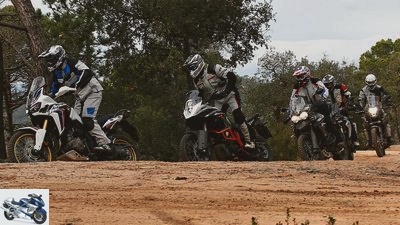
Jahn
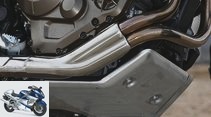
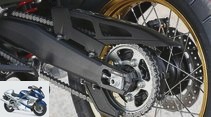
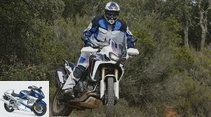
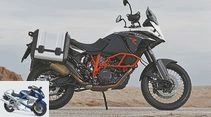
44 photos
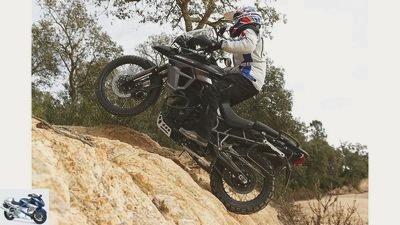
1/44
Triumph Tiger 800 XCA.
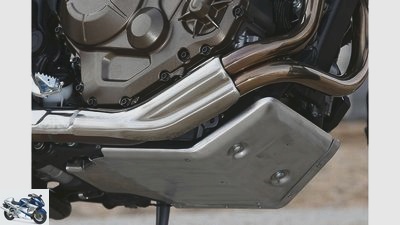
2/44
Honda CRF 1000 L Africa Twin.
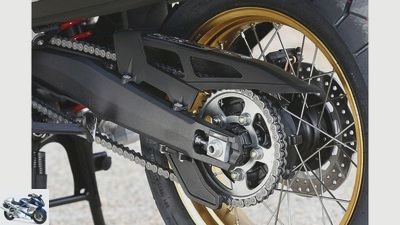
3/44
Honda CRF 1000 L Africa Twin.
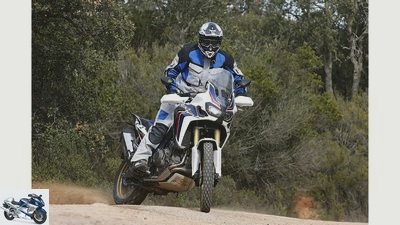
4/44
Honda CRF 1000 L Africa Twin.
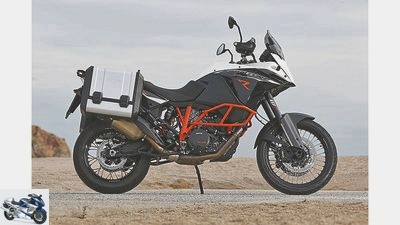
5/44
KTM 1190 Adventure R..
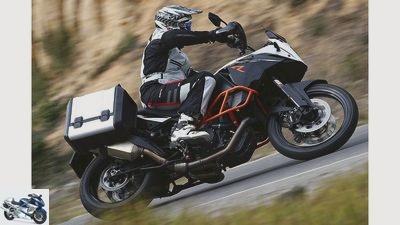
6/44
KTM 1190 Adventure R..
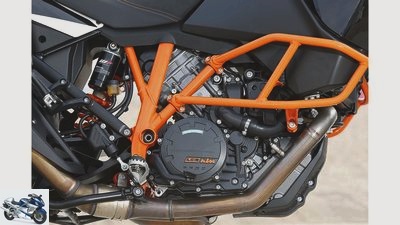
7/44
KTM 1190 Adventure R..

8/44
KTM 1190 Adventure R..
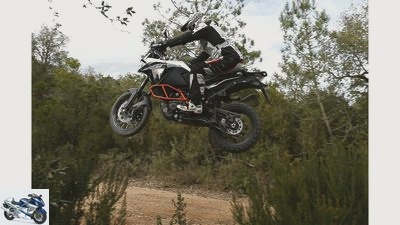
9/44
KTM 1190 Adventure R..
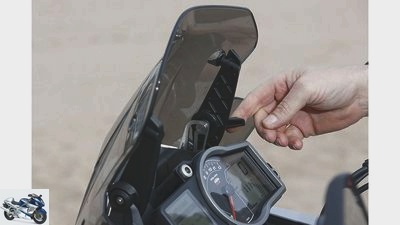
10/44
KTM 1190 Adventure R..
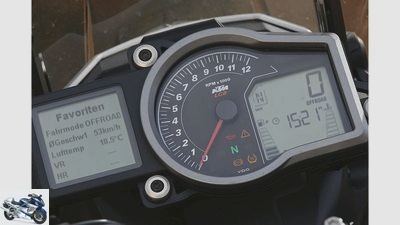
11/44
KTM 1190 Adventure R..
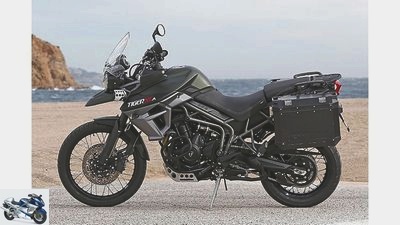
12/44
Triumph Tiger 800 XCA.
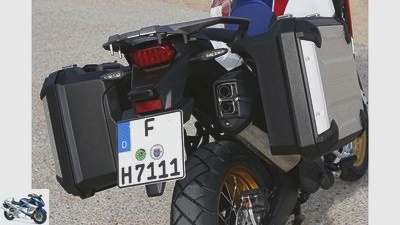
13/44
Honda CRF 1000 L Africa Twin.
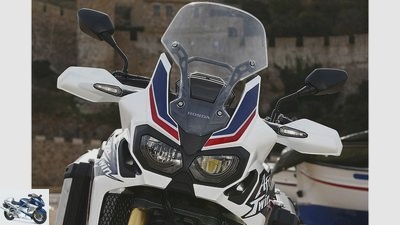
14/44
Honda CRF 1000 L Africa Twin.
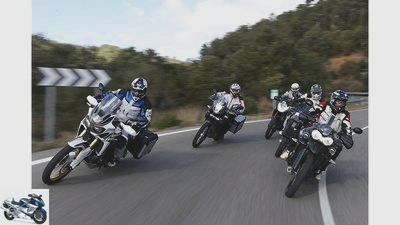
15/44
BMW F 800 GS, Honda CRF 1000 L Africa Twin, KTM 1190 Adventure R, Triumph Tiger 800 XCA and Yamaha XT 660 Z Tenere.
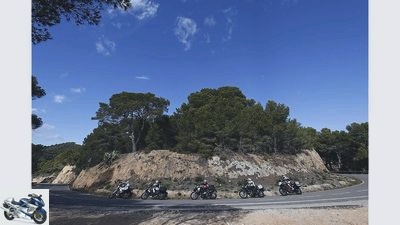
16/44
The five adventurers don’t just point on the country road …
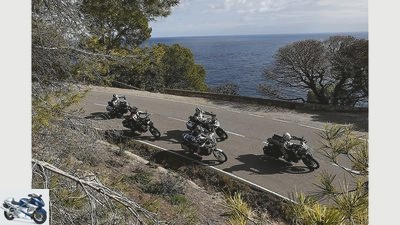
17/44
… but also when traveling …
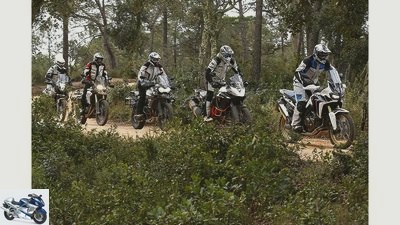
18/44
… and in the field, what they can do.
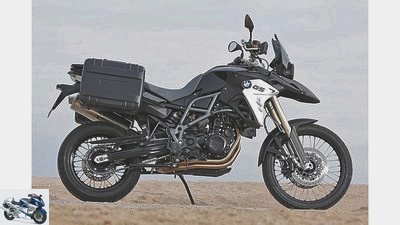
19/44
BMW F 800 GS with 798 cc and 85 PS.
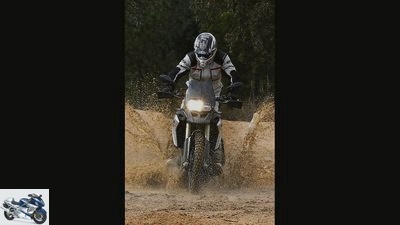
20/44
With the push of a button, the enduro mode on the BMW F 800 GS allows the rear wheel the right amount of slip.
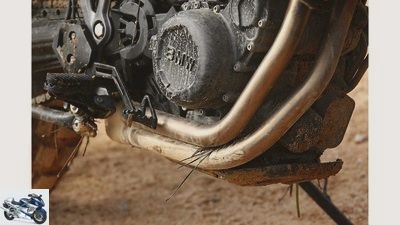
21/44
The Bavarian does well in challenging terrain.
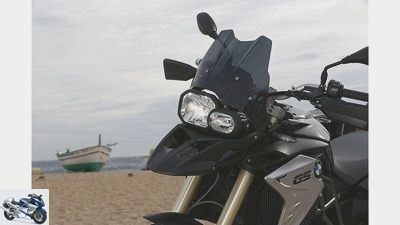
22/44
BMW F 800 GS.
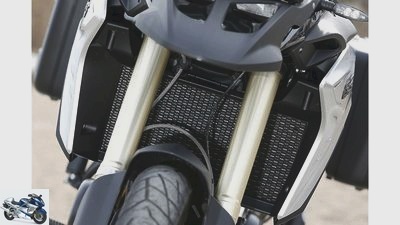
23/44
BMW F 800 GS.
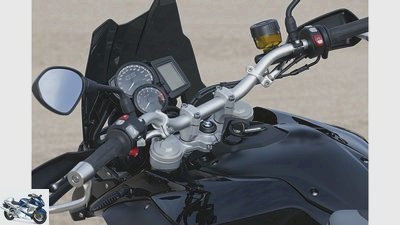
24/44
BMW F 800 GS.
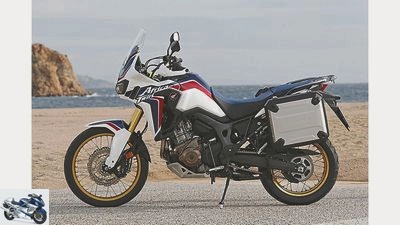
25/44
Honda CRF 1000 L Africa Twin.
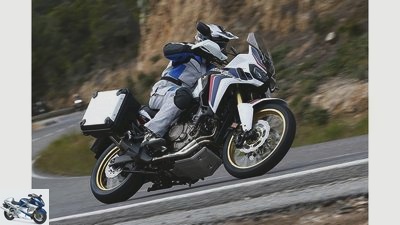
26/44
Honda CRF 1000 L Africa Twin.
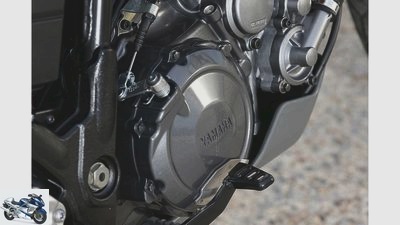
27/44
Yamaha XT 660 Z Tenere.
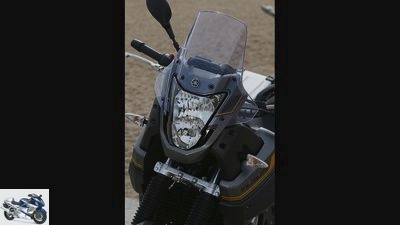
28/44
Yamaha XT 660 Z Tenere.
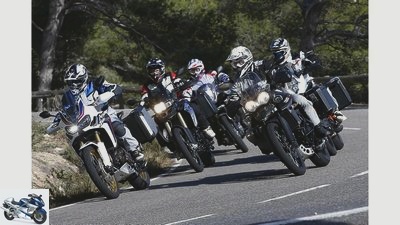
29/44
BMW F 800 GS, Honda CRF 1000 L Africa Twin, KTM 1190 Adventure R, Triumph Tiger 800 XCA and Yamaha XT 660 Z Tenere.
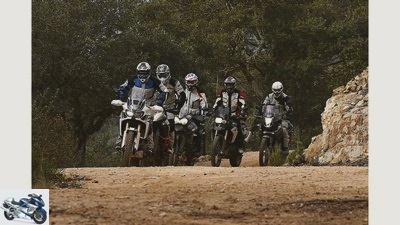
30/44
BMW F 800 GS, Honda CRF 1000 L Africa Twin, KTM 1190 Adventure R, Triumph Tiger 800 XCA and Yamaha XT 660 Z Tenere.
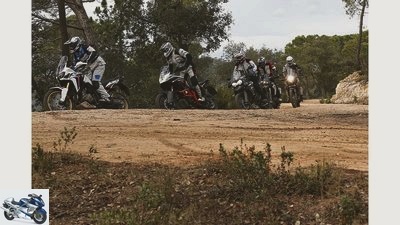
31/44
BMW F 800 GS, Honda CRF 1000 L Africa Twin, KTM 1190 Adventure R, Triumph Tiger 800 XCA and Yamaha XT 660 Z Tenere.
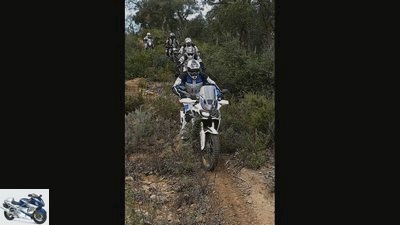
32/44
BMW F 800 GS, Honda CRF 1000 L Africa Twin, KTM 1190 Adventure R, Triumph Tiger 800 XCA and Yamaha XT 660 Z Tenere.
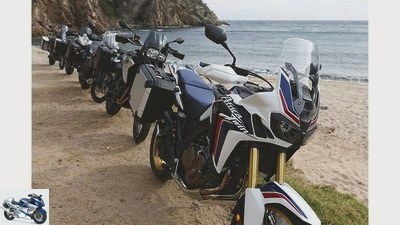
33/44
BMW F 800 GS, Honda CRF 1000 L Africa Twin, KTM 1190 Adventure R, Triumph Tiger 800 XCA and Yamaha XT 660 Z Tenere.
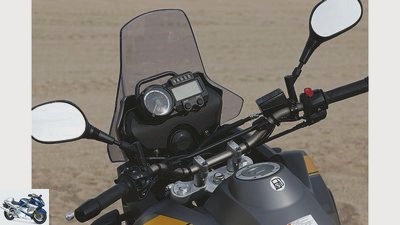
34/44
Yamaha XT 660 Z Tenere.
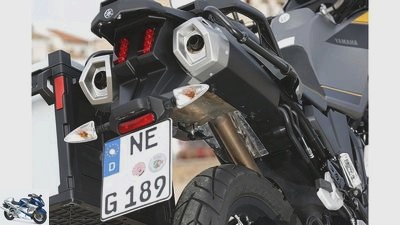
35/44
Yamaha XT 660 Z Tenere.
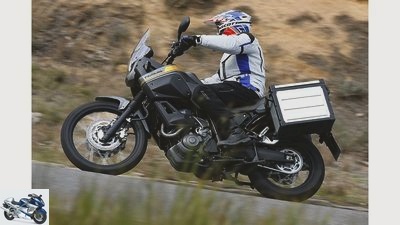
36/44
Yamaha XT 660 Z Tenere.
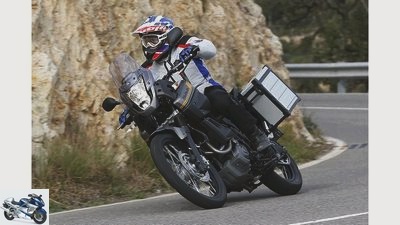
37/44
Yamaha XT 660 Z Tenere.
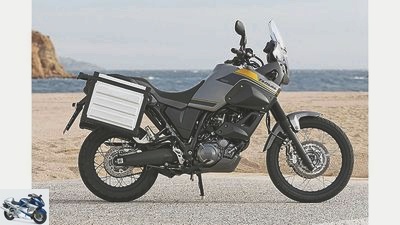
38/44
Yamaha XT 660 Z Tenere.
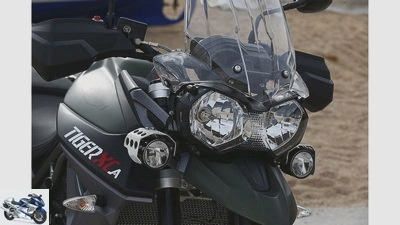
39/44
Triumph Tiger 800 XCA.
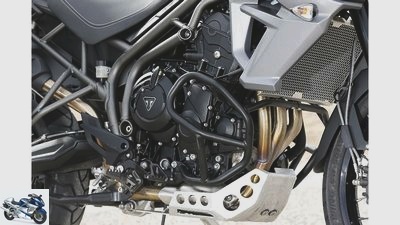
40/44
Triumph Tiger 800 XCA.
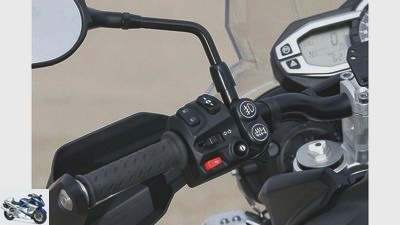
41/44
Triumph Tiger 800 XCA.
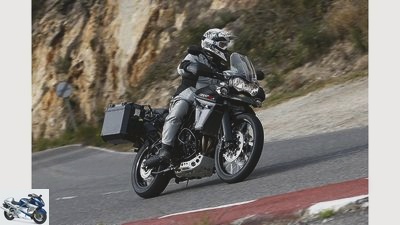
42/44
Triumph Tiger 800 XCA.
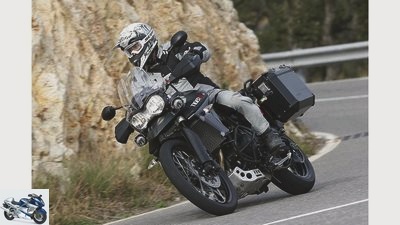
43/44
Triumph Tiger 800 XCA.
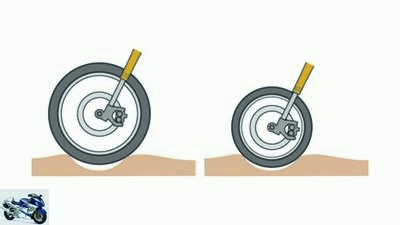
44/44
Bigger is better: A larger wheel (left) rolls more comfortably and with less resistance over bumps. The difference is clearly noticeable in the terrain.
Honda Africa Twin, KTM 1190 Adventure R, BMW F 800 GS, Triumph Tiger 800 XCA, Yamaha XT 660
Adventure enduros in a comparison test
Can the new Honda Africa Twin stand up to the established adventure group? A tour with the five travel enduros Honda Africa Twin, KTM 1190 Adventure R, BMW F 800 GS, Triumph Tiger 800 XCA and Yamaha XT 660 Z Tenere should clarify it. On the country road, on the autobahn – and into the countryside.
R.eiseenduros already have their conceptual claim in their name. You should cut a good figure when traveling, on the country road anyway and also be able to make your way roughly. A broad balancing act – which many concepts can no longer achieve. Because travel enduros have long since developed into tourers and comfortable country speedsters. The off-road aspect is reduced – almost parallel to the development of SUVs in the automotive sector – mostly only to optical borrowings.
Buy complete article
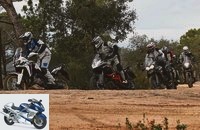
Honda Africa Twin, KTM 1190 Adventure R, BMW F 800 GS, Triumph Tiger 800 XCA, Yamaha XT 660
Adventure enduros in a comparison test
Tiger 800 XCA and Yamaha XT 660 Z Tenere unite.
Adventure enduros with a wide range of uses
With the KTM 1190 Adventure R, KTM has been committed to the plaice since it was launched in 2013. Only manually instead of electronically adjustable spring elements, longer spring travel, harder springs, more ground clearance, greater caster, wider handlebars and standard crash bars distinguish the dirt bike from its sister version. Triumph also offers two different model lines. XC, the abbreviation for Cross Country, is what the British call the off-road derivative of the Tiger 800. In addition to sturdy engine protection and crash bars, the Triumph Tiger 800 XCA equipment variant is equipped for dirty use with milled off-road footrests, fog lights, pannier racks, heated handles and seats as well as three on-board sockets.
At Yamaha, the Tenere is also based on the basic XT-660-R. With a large 23-liter tank, slim fairing and many other retouching, the Yamaha XT 660 Z Tenere optically borrows from rally machines. The little sister of the legendary Boxer GS, the BMW F 800 GS, is a stand-alone model. The Baby-GS has long been the first address for extreme travelers. The wide range of uses for these adventure enduros was undoubtedly also in the specifications of the developers of the Honda Africa Twin.
Subscribe to MOTORRAD videos on Youtube
Changes in the MOTORRAD 1000 point scoring
Manufacturers look for the goal in very different technical ways. The range of engines extends from the almost 50 hp 660 single-cylinder of the Yamaha XT 660 Z Tenere to the almost 150 hp Power V2 of the KTM 1190 Adventure R. Extreme, also in the price range of almost 10,000 euros for the Yamaha up to an impressive 17,000 euros for the KTM. In order to obtain the most comprehensive possible overall picture of the machines, four evaluations are included in this comparison.
The basis is the result of the MOTORRAD 1000 points evaluation (see "Performance measurements"). A note on this: From March 2016, this rating also includes the assessment of the electronic assistance systems. Subordinate criteria such as ground clearance are instead weighted less. For this reason, the number of points for the Honda Africa Twin rated in issue 4/2016 has been reduced from 699 to 694. Ultimately, the results from the country roads, travel and off-road ratings are based on the 1000-point rating. Please start the engines. It is traveled, ridden and crossed.
The test field
markus-jahn.com
BMW F 800 GS, Honda CRF 1000 L Africa Twin, KTM 1190 Adventure R, Triumph Tiger 800 XCA and Yamaha XT 660 Z Tenere.
BMW F 800 GS
markus-jahn.com
BMW F 800 GS.
- Water-cooled two-cylinder four-stroke in-line engine
- Displacement 798 cc
- 62.5 kW (85 PS)
- Weight with a full tank 222 kg
- Tank capacity 16.0 liters
- Test consumption 4.6 liters
- Range 348 km
- Price test motorcycle 12,495 euros (including comfort package: on-board computer, main stand, heated grips, case holder (450 euros), dynamic package: ASC, ESA, off-road mode ASC / ABS (620 euros); style package 2: Black Storm paint, Hand protectors, white LED indicators, tinted windshield (240 euros)
Honda CRF 1000 L Africa Twin
markus-jahn.com
Honda CRF 1000 L Africa Twin.
- Water-cooled two-cylinder four-stroke in-line engine
- Displacement 998 cm³
- Output 70.0 kW (95 PS)
- Weight with a full tank 238 kg
- Tank capacity 18.8 liters
- Test consumption 4.3 liters
- Range 437 km
- Price test motorcycle 13,864 euros (including main stand (219 euros), case set (645 euros), tricolor paintwork (300 euros), ABS / traction control (600 euros))
KTM 1190 Adventure R.
markus-jahn.com
KTM 1190 Adventure R..
- Water-cooled two-cylinder four-stroke V-engine
- Cubic capacity 1195 cm³
- Output 110.0 kW (150 PS)
- Weight with a full tank 244 kg
- Tank capacity 23.0 liters
- Test consumption 6.0 liters
- Range 383 km
- Price test motorcycle 17,015 euros (including case system (970 euros))
Triumph Tiger 800 XCA
markus-jahn.com
Triumph Tiger 800 XCA.
- Water-cooled three-cylinder four-stroke in-line engine
- Displacement 799 cm³
- Output 70.0 kW (95 PS)
- Weight with a full tank 241 kg
- Tank capacity 19.0 liters
- Test consumption 5.0 liters
- Range 380 km
- Price test motorcycle 14,060 euros (including black aluminum case (960 euros))
Yamaha XT 660 Z Tenere
markus-jahn.com
Yamaha XT 660 Z Tenere.
- Water-cooled single-cylinder four-stroke engine
- Cubic capacity 660 cm³
- Output 35.3 kW (48 PS)
- Weight with a full tank 218 kg
- Tank capacity 23.0 liters
- Test consumption 4.1 liters
- Range 561 km
- Price test motorcycle 9714 euros (including case system (1039 euros))
Performance measurements
Power on the crankshaft. Measurements on the Dynojet roller test stand 250, corrected according to 95/1 / EG, maximum possible deviation ± 5%.
The performance diagram documents the spread of the displacement in the test field. With 146 hp, the 1200 V2 of the KTM 1190 Adventure R sets its scent mark in the travel enduro segment. As in practice, the 1000cc engine of the Honda Africa Twin also impresses on the test bench with a continuous torque curve. The differences in character between the 800s from the BMW F 800 GS and the Triumph Tiger 800 XCA are also reflected in the engine’s speed reserves. Not surprisingly: the flat torque curve of the Yamaha XT 660 Z Tenere.
MOTORCYCLE 1000 points evaluation:
| maximum number of points | BMW F 800 GS | Honda CRF 1000 L Africa Twin | KTM 1190 Adventure R. | Triumph Tiger 800 XCA | Yamaha XT 660 Tenere | |
| Overall rating | 1000 | 653 | 694 | 696 | 672 | 578 |
| placement | 4th. | 2. | 1. | 3. | 5. |
Comparison on the country road
markus-jahn.com
Where it counts is the country road.
It’s nice when a concept is as universal as that of the adventure bikes. But the same applies to the Adventure League: where it counts is the country road. Did someone really count them? The road should hit a hook 365 times on the 23 kilometers between Tossa de Mar and Sant Feliu de Guixols. Hairpin bends and arches carved into the rock between the steep face and the sparkling blue sea. The asphalt strip is said to be one of the most beautiful in Europe. It is definitely one of the most demanding drivers.
Quite gentlemen, the two- and three-cylinder drivers let the driver of the Yamaha XT 660 Z Tenere go first. Maybe the big ship captains just don’t want to embarrass themselves. Because in this jumble of curves, it is not top performance that counts, but smooth load changes, nimble handling and good steering precision. Basics: Due to the smaller contact area, the 90 millimeter narrow 21-inch models offer less liability reserves than the 19-inch models (mostly 110 mm wide) of conventional travel enduros. At higher speeds, a large front wheel also turns more slowly due to the higher gyroscopic forces. But: because of the narrow front tires, the adventure enduros don’t stand up when braking.
Non-adjustable telescopic fork of the XT provides little feedback
With its slim figure, the Yamaha XT 660 Z Tenere makes friends. The 23-liter fuel drum is tall, keeping the knee narrow. And with the 130 rear tire (Metzeler Tourance), the XT tilts into a lean position as if with a snap of a finger. The 49 hp 660 stew of the XT is typically single. If you want to keep the four-valve engine in the narrow comfort range between 3000 rpm and 6000 rpm, you have to do one thing above all: shift frequently.
The Yamaha XT 660 Z Tenere, which is so good-natured at a moderate pace, is also stressed during a somewhat brisk ride. The conventional, non-adjustable telescopic fork delivers little feedback, the front floating caliper brake feels doughy and the deep seat hollow cement the pilot’s driving position. Not a broken leg and certainly not a conceptual weakness of the stew, but enough to have to wave past the more precise driving and more homogeneously coordinated competition.
Triple the Triumph Tiger 800 XCA pushes buttery smooth
The high-frequency whistling three-cylinder out the Triumph Tiger 800 XCA can be seen from afar. Or is it the pilot who whistles a song in a good mood? He would have reason to. From idle the triplet pushes smoothly, accelerates in the curves with almost no load change reactions, can be taken for a whispering walk in the lower speed range or hissing on the leash, impressing once again with the universal three-cylinder engine concept. Especially since the chassis is convincing.
Whether it’s the steepest steering angle, the shortest caster, the second shortest wheelbase in the field or the front-facing positioning of the engine in the chassis, the fact is: the front wheel of the Triumph Tiger 800 XCA sticks as if nailed to the corner, conveying a real sense of trust. Despite the 21-inch wheel. Nevertheless: The 800 does not hide its 241 kilograms (only three less than the KTM 1190 Adventure R), it needs some strength in alternating bends – and restraint when tilting. Even without the extra-long fear nipples, the beautifully milled but deeply attached footrests paddle across the asphalt early.
BMW F 800 GS impresses with its uncomplicated style
The BMW F 800 GS offers virtually unlimited freedom of lean angles. The handling is good, the feedback is only slightly below the level of the Triumph Tiger 800 XCA. The Bavarian convinces with a completely uncomplicated manner. None of the five steers so directly, can be thrown from one angle into the next with so little force.
With a boxer sound, the synchronous runner, which ignites with a 360 degree offset, pushes ahead, animated with low-frequency pulsing, also emotionally. Only the non-adjustable fork of the BMW F 800 GS dips a little too deep when braking in high spirits. Keyword braking: Despite the floating caliper (like the Triumph retarders from Nissin), the Brembo station wagon decelerates properly, but lets the spoiled call for a slightly clearer pressure point and feedback.
Series tires for the Honda Africa Twin are not ideal
The Honda Africa Twin loves to answer the call of the country road, with a 200 cm³ displacement advantage, already in the speed range lower than the two 800s (see performance diagram). Although the twin with a 270 degree crankshaft offset technically imitates a 90 degree V2 engine, the Unicam propellant has its own character. He gets going with momentum, intuitively letting the pilot level the chocolate side between 3000 rpm and 7000 rpm. Not that the newbie would be petulant below or above. On the contrary. With two balancer shafts and a correspondingly good nursery, the Twin attracts above all in a cultivated way at the bottom.
It is probably due to this early start that the two-cylinder engine is forgiven for its engine speed limit of 8200 rpm, and not even knocked on it. In any case, the drive is more or less a congenial partner of its Susi-carefree chassis coordination. As later in the field, the centralization of the masses propagated by Honda at the Africa Twin actually seems to have an effect. The 238 kilogram Honda Africa Twin doesn’t actually feel light, and yet it falls into bends as if by itself, exuding a noticeable balance and stability – for example when turning. Erect and bend, brake, shift, couple, everything is wonderfully easy to do, and it forms a harmonious whole. That is only disturbed by the series tires. The Dunlop Trailmax D 610 do not want to match the Africa Twin at all, steer imprecisely and provide little feedback. MOTORRAD will soon be trying out replacement tires.
Punch of the KTM 1190 Adventure R leaves no one indifferent
Speaking of tires. The towering front of the KTM 1190 Adventure R is the only one on the test field that reminds us that the adventure bikes have 21-inch front wheels (see also "Why 21 inch front wheels?") roll. Off-road, rally, racing – these are the keywords when the KTM wakes up. How was that? Doesn’t performance matter in cornering nirvana? Maybe not top performance. But the punch of the 1200 V2 leaves no one indifferent.
It’s unbelievable how lively the 1190 hangs on the gas, how easily the clutch and gearbox slip. Every corner exit mutates into a dragstrip on the Austrian. Strolling? You could. No worse than the other four. But why? It would be a shame about the first-class brake system with elegant radial fittings or the clean line that the KTM 1190 Adventure R pulls in every curve despite the tall forehand – and thus not only sets itself in the limelight between Tossa and Feliu. For what is probably the most off-road-oriented concept in this test field, it is actually a surprise.
Country roads scoring
- KTM 1190 Adventure R
- Honda CRF 1000 L Africa Twin
- BMW F 800 GS
- triumph Tiger 800 XCA
- Yamaha XT 660 Z Tenere
Off-road comparison
markus-jahn.com
The five should prove that the theme of adventure is not just in the name.
Fine rib down, coarse knit on. With Conti TKC 80 coarse stollers, the five should prove that adventure is not just a part of the model name. How was it? See what’s up. Already optically, the Conti TKC 80 harmonize with the adventure quintet. Functionally anyway. With a wider limit area, the Grobstoller offer more grip on sand and gravel. It is understandable that the Yamaha rider first turns into the dusty element. What the Yamaha XT 660 Z Tenere may have been missing on the country road, it promises to catch up in the sports lesson. Single cylinder engine, rally optics, glorious family history. That would have to fit between rock and bush. But it doesn’t.
Not only that, against this background, the shortest spring travel (160/145 mm) in the test field is surprising. The non-adjustable, underdamped fork hops diffusely over the edges, the stiff shock absorber reluctantly passes on hard hits, and the engine looks rough around the supple two and three-cylinder. Even its theoretical weight advantage is hardly implemented in practice, at 218 kilograms it weighs only four kilograms less than the BMW F 800 GS. After all: With the good-natured single, she can do without mapping gimmicks and traction control. The ABS, which cannot be switched off, could still work better. Barely acceptable on smooth slopes, the defensively tuned anti-lock device intervenes overly cautiously on bumpy terrain, giving the XT driver involuntarily rapid descents. And reminds him: The ravages of time, he gnawed at the concept of the Yamaha XT 660 Z Tenere.
KTM the heaviest at 244 kilograms
Camouflage color, crash bars, massive engine protection and in the XCA model variant with sharply jagged footrests, the Triumph ambitiously plunges into the green. And hand on heart, you wouldn’t have expected the beefy Triumph Tiger 800 XCA to have so much fun in sandpit games. The spring elements of WP Suspension cleanly put away washouts and respond sensitively on slow single trails. There the three-cylinder also throws itself into the stuff, finds every ounce of traction with its buttery soft insert. ABS and traction control shine in off-road mode with practical control. Nevertheless: With just under 180 millimeters of ground clearance, the aluminum protection often scrapes over the gravel, the massive triplet presses noticeably on the front and subjectively makes the Tiger appear heavier than the weighed 238 kilograms. Not a broken leg and yet weak enough to open the flank to the hardcore off-roaders.
Because the sand of the Dakar still seems to be sticking to the Adventure R from KTM. Even in off-road driving mode, the V2 of the KTM 1190 Adventure R, which is capped to 100 hp, still bites, as if it were on the final sprint across the Andes. The traction control allows a lot of slip, the ABS allows braking maneuvers that even professionals can hardly beat. Even daring jumps can only test the limits of the comparatively soft fork, but not the maximum ground clearance of 25 centimeters or that of the stiff spring strut. Experienced personnel are needed for this heavy pressure, sporty ones to climb to a seat height of 920 millimeters and strong ones to keep the quintet’s heaviest total weight of 244 kilograms in the vertical. And if you take it easy, you should keep the front section, which occasionally wriggles in spite of the steering damper, firmly under control.
KTM and BMW close together
Which is why the duo of BMW and Honda stalked the Austrian unobtrusively in the dust plume. In the case of the BMW F 800 GS, this is understandable. After all, the baby GS has long outstripped her sister’s boxer among long-distance travelers. And the Bavarian does well in challenging terrain too. With a seat height of 920 millimeters (the GS can also be ordered with a 30 mm lower seat), it also wants to be climbed first, but once in the saddle the GS driver feels comfortable. The rear tank allows a narrow knee closure, with the sitting position moved close to the handlebars, the Bavarian steers very front-wheel-oriented and directly and can be saved with a moderate 222 kilograms – only four kilograms more than the single-cylinder Yamaha XT 660 Z Tenere – even in dicey situations.
The uncomplicated appearance is rounded off by the 800 twin. The synchronous runner starts smoothly with a 360 degree ignition offset and does not get lost in the mapping. A push of a button and the Enduro mode allows the rear wheel the right amount of slip, and challenges even experienced off-roaders when braking to the limit – like the KTM 1190 Adventure R and Triumph Tiger 800 XCA. Switching off ABS and TC completely is only worthwhile in extreme cases. This is where the relatively soft, non-adjustable fork comes up against its limits and breaks through dry, for example in the case of angular washouts. Forgivable, because with a homogeneous overall picture the BMW F 800 GS catches up with the KTM in the bushes.
markus-jahn.com
The KTM is one step ahead on the country roads. And in the field?
Hand on heart that the German-Austrian high-performance duo would have to take on the Honda of all things in the dusty element, one would not have expected. Because both in terms of weight (238 kg) and its chassis geometry, the Honda Africa Twin ranks rather inconspicuously among the crowd. And yet at the CRF: The whole is more than the sum of its parts. The concentration of the masses, the main development concept of the Africa Twin, can be felt from the first meter.
Well balanced, the new one rolls along the country lanes and can be steered unusually easily by shifting your weight on the footrests. You quickly gain trust and become bolder. Drift? With the left index finger, switch off the three-stage TC while driving, open the gas – and the Honda Africa Twin stands sideways. Precise, dosed to the meter, with minimal risk of falling. Great. This is certainly also due to the linear performance range of the two-cylinder, with which the CRF can be easily controlled even on steep gravel climbs – similar to the Triumph Tiger 800 XCA. And the descent? No problem. The ABS cannot be switched off at the front.
Honda Africa Twin off-road in a class of its own
After the off-road button is pressed, the front wheel bites into the ground just above the blocking limit, as does that of the BMW F 800 GS, KTM 1190 Adventure R and Triumph Tiger 800 XCA. For the final coup, however, the Honda Africa Twin is currently pulling out on the swift paths crossed by gullies.
There, the smoothly dampened Showa spring elements not only respond sensitively, but also offer by far the greatest punch reserves of the five-man group and put the 19 centimeters into perspective (Triumph Tiger 800 XCA, Yamaha XT 660 Z Tenere: 18 cm, BMW F 800 GS 22 cm, KTM 1190 Adventure R 25 cm) only moderate ground clearance. Impressive. Even the relatively soft rebound stage damping on the shock absorber (MOTORCYCLE setting: turned down to a click) does not make the rear pump – and the Africa Twin pilots are in high spirits. Because even more than the KTM on the country road, the Honda Africa Twin provides a big surprise off-road with this all-round polished appearance.
Off-road rating
- Honda CRF 1000 L Africa Twin
- BMW F 800 GS
- KTM 1190 Adventure R
- triumph Tiger 800 XCA
- Yamaha XT 660 Z Tenere
Fitness to travel?
markus-jahn.com
Now you can see whether you can travel comfortably on the Universal Talents.
The adventure bikes have already come through challenging country roads and demanding terrain well. Can you also travel comfortably on the Universal Talents? How do they say? Nothing is as certain as change.
With the KTM 1190 Adventure R, of all things, a markedly enduristic concept wins the country roads ranking, while a newcomer shines off-road with the Honda Africa Twin. Time to pack your bags. For the return trip – and to explore the capabilities of these adventure bikes in their third core competence, the journey.
Case of the BMW F 800 GS convince
Suitcase clicked into the carrier and departure. Nice: With the Honda Africa Twin and KTM 1190 Adventure R, the suitcases do not leave any ugly carrier tubes behind on the luggage-free tour thanks to integrated mountings on the rear. And: With their variosystem, which can be easily pulled out with the hand lever, the cases of the BMW F 800 GS are once again impressive. The high-quality Honda cases slide into their holders as if by themselves and at 645 euros only cost half as much as the counterparts of the sister model, the Crosstourer.
After just a few kilometers inland, only memories remain of the grandiose coastal road. Meters on straight, unadorned national roads. Again, the Yamaha XT 660 Z Tenere sets the pace as the weakest of the group. With the narrow and raised fairing, the XT Rallye exudes flair and also protects the driver well from the wind. Apart from the sitting position cemented by the seat recess, it is easy to bear. It should. Because with less than five liters of travel consumption and a 23-liter tank, the XT driver only has to refuel after 450 kilometers. In the meantime, the single throbbing noticeably, but not annoying. All right: the non-adjustable, but firm rebound damping of the shock absorber keeps the XT on course even when loaded. The Tenerist has to be modest with the smallest suitcases (30 liters each) in the test field. Appropriate to the displacement, the performance, the price – and certainly also to the expectations of the traveling qualities of the single cylinder.
KTM and Yamaha with the largest tank volumes
The BMW F 800 GS already sets a record while packing: It is clearly the easiest to balance on the main stand. And offers both pilot and passenger the most secluded spots. The GS driver shouldn’t pull too hard on the gas. Because behind the low shield there is a strong breeze, and from 6000 rpm the twin vibrates vigorously despite the compensating rod. Boxer pilots spoiled by ESA also have to rethink. The handlebar switch only acts on the rebound damping of the monoshock. The differences between the three variants are large, but the spring must be preloaded using a handwheel. There is nothing to adjust at the fork.
And if the Mini-GS is to be blamed for even the smallest details for the tour, you can feel that the 800 simply feels more comfortable when scratching bends or in the bushes. Like the KTM 1190 Adventure R. Of course, the largest suitcase (42/31 liters) or the largest tank volume (23 liters) together with the Yamaha XT 660 Z Tenere, and even the longest inspection intervals (15,000 km) speak in favor of the large ones Trip. But the moderate wind protection, the tight bench, the sporty designed spring elements and last but not least the high consumption (up to 7.5 liters) pull the sports cannon into a twist.
markus-jahn.com
Which bike wins the travel rating?
In contrast to the Triumph, which also impresses on the track with its all-round convincing engine. Slogan: running culture. It couldn’t be better. The low, adjustable seat height is also pleasing. Just like the WP spring elements, which can be adjusted over a wide range and dampen cleanly, or the three twelve-volt sockets plus handle and seat heating in series. With a warm bottom, the tiger trainer will leave the widest suitcase (99 cm) just as cold as the complicated electronics. Apart from the impressive tariff of the Triumph Tiger 800 XCA of over 15,000 euros.
Not an easy opponent that the Honda Africa Twin faces with the Englishwoman between the motorway entrance and the toll booth. But even without a heating pad, the Honda pleases with comfortable accommodation for both pilot and passenger. In addition to the seat cushion, the traveler is particularly pleased with the – patented – windshield. Even without adjustment options, it offers great protection without turbulence or droning. A rare combination. In general, the CRF goes back to work with its uncomplicated attitude. The twin purrs inconspicuously on the slopes, hardly vibrates and remains frugal with 5.2 liters at 130 km / h. However, the Africa Twin can only set itself apart from the Triumph Tiger 800 XCA in tippy steps.
Africa Twin takes over the presidency of the Adventurer League
Only the details already mentioned, such as the good wind protection, the high-quality luggage system, the easier jacking up or the spring base that can be changed at the rear using a handwheel instead of an Allen key, allow the Japanese to compensate for the opulent equipment of the Triumph Tiger 800 XCA and gradually gain distance.
A distance with which the Honda not only secures victory in the travel standings, but also ultimately takes over the new chairmanship in the adventurers’ league after the formidable excursion into the terrain and the solid appearance on the country road. The Africa Twin may technically fit into this environment, but conceptually it has a more universal claim and sees itself more as a competitor to conventional travel enduro bikes. The Honda Africa Twin is still facing the big test. And who knows: you can do one thing without leaving the other.
Travel rating
- Honda CRF 1000 L Africa Twin
- triumph Tiger 800 XCA
- KTM 1190 Adventure R
- BMW F 800 GS
- Yamaha XT 660 Z Tenere
MOTORCYCLE overall result
markus-jahn.com
BMW F 800 GS, Honda CRF 1000 L Africa Twin, KTM 1190 Adventure R, Triumph Tiger 800 XCA and Yamaha XT 660 Z Tenere.
1. Honda CRF 1000 L Africa Twin
The world has been waiting for the Africa Twin – and Honda has delivered. The new Honda Africa Twin convinces not with its myth, but with universal capabilities.
2. KTM 1190 Adventure R
KTM can do offroad. Logical. But the basis for success is the big bike on the country road. Power-V2 in a high-quality chassis – pure explosive.
3. BMW F 800 GS
Handy off-road, nimble on country roads – the Baby-GS sets the focus. She thinks less of traveling. But the overall package pleases.
4. Triumph Tiger 800 XCA
The combat equipment is deceptive. The Tiger is an excellent road sweeper and an even better travel machine. Offroad? Well.
5. Yamaha XT 660 Z Tenere
The XT cannot implement the theoretical advantage of a single cylinder (low weight, good handling) in practice. Your concept is old.
MOTORCYCLE overall ranking
| BMW F 800 GS | Honda CRF 1000 L Africa Twin | KTM 1190 Adventure R. | Triumph Tiger 800 XCA | Yamaha XT 660 Tenere | |
| 1000 point evaluation | 4th. | 2. | 1. | 3. | 5. |
| Country roads scoring | 3. | 2. | 1. | 4th. | 5. |
| Off-road rating | 2. | 1. | 2. | 4th. | 5. |
| Travel rating | 4th. | 1. | 3. | 2. | 5. |
Overall placement
Conclusion
markus-jahn.com
Deserved winner in the comparison test: the new Honda Africa Twin.
Many motorcycles have already failed because of excessively high expectations. The new Africa Twin could also have been broken by its own myth. But the Honda developers have managed to resume the legendary spirit. With a well thought-out concept, down-to-earth technology and electronics reduced to the senses, the new Honda Africa Twin has also become what the old one was: an excellent all-rounder. Uncomplicated on the journey, solid on the country road and excellent off-road.
Apart from the Yamaha, which is disadvantaged with its single-cylinder concept, the Honda adventure group can still stand up to the individual disciplines. Traveling on the comfortable Triumph Tiger 800 XCA is extremely comfortable, the sporty KTM 1190 Adventure R is superior to the Africa Twin on the country road, and off-road the Austrian and the BMW F 800 GS are also on the heels of Honda. Only: Convincing across the entire spectrum, that is only possible with the Honda Africa Twin. The myth lives.
Why 21 inch front wheels?
archive
Bigger is better: A larger wheel (left) rolls more comfortably and with less resistance over bumps. The difference is clearly noticeable in the terrain.
Conventional travel enduros steer with 17 or 19 inch front wheels. Adventure bikes use 21 inch wheels. MOTORRAD explains why.
Anyone who has ever pushed a stroller over a gravel yard will confirm that small wheels roll uncomfortably on bumpy surfaces. Manufacturers take advantage of the advantage that larger wheels roll over unevenness more easily with offroad-oriented concepts.
Modern 21-inch tires also suitable for everyday use
The difference in diameter between the 19-inch wheels installed at the front of conventional travel enduros and the 21-inch wheels used in the Adventure variants is around four centimeters. The difference is clearly noticeable on bumpy terrain, and the motorcycle rides much more comfortably over lateral grooves or bumps.
The 21-inch models (90 millimeters) also differ in the tire widths from their 19-inch counterparts (110 millimeters). The reason: Due to the narrow contact surface, the tire cuts more easily into the ground in the terrain, thus guiding the front more precisely in loose terrain. In addition, the slim contour gives the tire more space in the ruts, and in these situations it behaves more neutral in its steering. No effect without side effects: on the road, the smaller contact surface (Latsch) of the narrow 21-inch tire is reflected in reduced liability reserves. In this test, however, not only the KTM 1190 Adventure R (Conti TrailAttack 2) proves that modern 21-inch tires still cut a very good figure in everyday use on the road.
Price comparison of used Adventure Enduros
1000PS marketplace app
Most Adventure Enduros already have the most important accessories.
Travel enduros that have off-road capabilities are in demand and the used market can fortunately satisfy the demands of enduro fans. There is a large selection of used adventure enduros available, many of which have the necessary accessories. All offers of used adventure travel enduros can be found here: used adventure enduros in Germany.
Related articles
-
Jahn 34 Pictures Jahn 1/34 Jahn 2/34 Lonely: The KTM is the only one of the Adventure Enduros to stay with chain drives. Light, but in need of care. Jahn 3/34 …
-
The enduro mega test part 1: travel enduros up to 800 cm³
Photos: Jahn 29 photos Jahn 1/29 Magnificent panorama of the Pyrenean peaks around the Col d’Ares. Jahn 2/29 Fantastic bikes, fantastic weather. Jahn …
-
BMW F 800 GS and Triumph Tiger 800 XCx in comparison test
fact 37 pictures fact 1/37 Triumph Tiger 800 XCx. Triumph 2/37 Not a bargain, but a two plus proves: The Triumph Tiger 800 XCx offers a lot of technology …
-
Big travel enduros put to the test at the 2014 Alpine Masters
Photo: fact / Joachim Schahl 13 photos fact / Joachim Schahl 1/13 The travel enduros Suzuki V-Strom 1000, KTM 1190 Adventure, Triumph Tiger Sport, Yamaha…
-
Middle-class all-rounder in a comparison test
markus-jahn.com 31 pictures markus-jahn.com 1/31 mid-range all-rounder in comparison test – Honda Crossrunner, Kawasaki Versys 1000, Triumph Tiger 1050 …
-
Comparison test travel enduro bikes: Part 3
25 pictures 1/25 Comparison test travel enduro 2013. 2/25 Comparison test travel enduro 2013. 3/25 Always on …
-
Five mid-range travel enduros (2019) in a comparison test
Theme special Everything about BMW Motorrad Tyson Jopson, Stefan Kaschel, Arturo Rivas 29 photos Tyson Jopson, Stefan Kaschel, Arturo Rivas 1/29 We have…
-
Eight large touring motorcycles in a comparison test
Photo: 24 photos 1/24 BMW R 1200 GS Rallye, Moto Guzzi Stelvio 1200 8V, Triumph Tiger Explorer, KTM 990 Adventure, Kawasaki…
-
BMW F 800 GS Adventure, KTM 1190 Adventure R in the test
Jahn 32 pictures Jahn 1/32 Concept comparison Adventure Enduros: BMW F 800 GS Adventure against KTM 1190 Adventure R. Jahn 2/32 Concept comparison …
-
BMW, Kawasaki, Triumph and Yamaha Tourer in comparison test
Gargolov 31 pictures Gargolov 1/31 Tourer comparison test: Triumph Trophy SE, BMW R 1200 RT, BMW K 1600 GT, Yamaha FJR 1300 and Kawasaki 1400 GT. Gargolov …